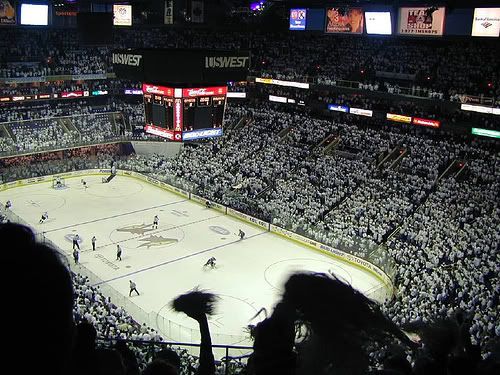We have analyzed the 2008-2009 attendance data by division. The divisions are divided geographically for the most part, so our hope is to answer the question many fans (especially Canadian fans) have posed: is hockey’s expansion to non-traditional markets good or bad for the game?
2008-2009 ATTENDANCE FIGURES BY DIVISION:
ATLANTIC DIVISION: 16,851 (92.9%)*
NORTHEAST DIVISION: 19,020 (100.2%)
SOUTHEAST DIVISION: 16,282 (82.7%)
PACIFIC DIVISION: 16,704 (96.8%)
NORTHWEST DIVISION: 17,751 (95.9%)
CENTRAL DIVISION: 18,243 (93.6%)
*=Capacity percentage was determined by dividing average attendance within the division by average arena capacity within the division.
Not surprisingly, the Southeast’s numbers are significantly less than any other division and by quite a bit. Two franchises in Florida, one in Georgia and one in North Carolina will do that to you. Despite the Capitals averaging over 18,000 people last season, they averaging 14,720 in their last season before drafting Alexander Ovechkin; not a surprising number by any stretch. The point? The Southeast expansion may have backfired. Despite the Stanley Cup going to Tampa Bay and to Carolina in 2004 and 2006 respectively, the division doesn’t have much else to boast.
That being said, the Central Division, which puts the 2nd most people in the seats, has two of the Original Six teams. Coincidence? Hardly. The Blackhawks resurgence as well as the perennial success of the Red Wings has lead to a spike in attendance in the Central. It was also the first Blues playoff season is years which contributed to high numbers.
The Northeast boasts a ridiculous attendance ratio, but also has three Original Six teams in the Bruins, Maple Leafs, and Canadiens. The Senators, another Canadian team, are also situated in this division and Buffalo, which many now consider to have taken the “Hockeytown U.S.A.” crown, also blow up the numbers. The tradition in this division will lead to high numbers annually no matter how the team produces on the ice. In Southern divisions, attendance can be attributed to winning. The Tampa Bay Lightning fielded the 2nd worst team in the NHL in 2008-2009 and saw their attendance dip to 21st in the NHL. But when the team was on their Stanley Cup quest in 2003-2004, their attendance was 12th in the NHL.

Above: The Coyotes had no problem attracting fans during winning times.
For hockey to succeed in non-traditional markets, it must field a winning product. The exception to this may be the current Phoenix Coyotes, who sit 4th in the highly competitive Western Conference but amidst filing for bankruptcy, relocation threats, and being owned by the NHL, are last in 2009-2010 attendance and are averaging a measly 10,732 fans per game.
It is no secret that fans in Canada will come out to support their teams no matter what; as we further break down the 2008-2009 numbers this becomes more evident. The Maple Leafs filled the Air Canada Centre at a 102.7% clip last year despite picking 5th in the 2009 Entry Draft. Of the top 10 teams in 2008-2009, five were Canadian teams (the exception being the Oilers) and four were Original Six teams. The four Original Six teams were in the top five in the entire NHL in league attendance. The Original Six team with the worst attendance in 2008-2009 was the Bruins, but even they filled the building at a 97% pace.
The verdict? It is a more difficult draw to put teams in non-traditional markets and winning definitely helps. Some gambles have succeeded; the three California teams (Los Angeles, San Jose, and Anaheim) have all been very successful. But in the southeastern United States, where football and baseball will always reign supreme, fan bases support winners. Even the Atlanta Thrashers, who drew less than 10,000 people in their January 7th victory over the Rangers, had eleven sellouts in their 2006-2007 season which saw them win the Southeast Division and make the playoffs for the only time in franchise history.
Fans will always support teams with history; those in markets that won’t host a Winter Classic any time soon need to start winning if they want to keep their place in the NHL. Hamilton is always waiting.




No comments:
Post a Comment